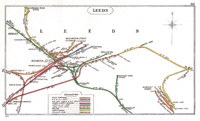GCR London Extension stations - Nottingham Victoria
Channel 5's "Walking Britain's Lost Railways"
It helps to start with an episode of this series about the GCLE between Nottingham Victoria-Rugby Central which I watched with gritted teeth. There were almost twenty cases of error and fabrication, some of them tabloid-style. The raison d'etre given for construction of the Extension was baloney and among the locations portrayed, Catesby Tunnel - which cuts through the high ground of the Northamptonshire Wolds and is well known for its deep ventilation shafts (still there and a sight to see) - was stated as "was planned to be a cutting". It's sad to see so much baloney about this line which I shall be dealing with in due course.
Misrepresentations at Nottingham included erroneous easy gradients and presentation of the Mansfield Road tunnel end at Nottingham Vic as if the whole site was that deep. In fact, most of the site was so shallow that buildings had to be supported to enable the railway to pass beneath. Amid constant reference to demolition of houses it wasn't mentioned that the GCR replaced a good deal of the slum area - whose removal (and hence the local prison), the Council endorsed wholeheartedley - with new houses. And that some of the new streets acquired GCR-related names, such as Watkin Street. It wasn't even the only place along the GCLE where this sort of thing happened.
Parts of the C5 programme were on a media shock-horror basis and this isn't the place to correct the whole shebang, but I can offer illustrations showing what the station site actually looked like and an idea of the services that it offered for local people, rather than a fabricated notion of "high-speed freight" which was presented as the raison d'etre for building the GCLE.
I've been told that programmes like this are "for entertainment" and despite pretentions to the contrary, clearly lack historical credibility. C5 actually contacted me just before the programme was aired and took no notice of me pointing out fundamental errors.
Nottingham Victoria
Showing what Nottingham Vic actually looked like and correcting baloney in the C5 programme is the best that can be done at the moment and the sequence so far is:
1 - The station buildings 2 - The deep north end 3 - The shallow middle and south end 4 - Up non-passenger facilities 5 - Down non-passenger facilities 6 - Secondary services - GC Section 7 - Secondary services - GN Section 8 - Specials
At present, two sections about the services don't cover long distance expresses which called at Nottingham Vic, the emphasis is on what might be called "local" Ordinary Passenger services which tend to fall under the radar.
New additions placed here temporarily
This picture shows the downside NPCS platform and the descending approach from street level on the other side of the bridge in 1958 - and is also under "Parcels Traffc in BR Days" because it the loco (ex-GCR D11 No 62668 Jutland which was transferred to Darnall that year) is facing northwards with a GWR design Siphon G, the last of these built by BR during the 1950s and looking good in BR crimson.
The loco is carrying a random single lamp in the manner of a light engine but unfortunately it's impossible to tell if it's backing into the bay or coming out of it. Nor is it possible to tell if the move is associated with a parcels or a passenger train. I suspect it may be the latter although it's also possible that the loco was acting as a station pilot but not carrying pilot lights (one over each buffer at both ends). Sorry, folks, there are too many possibilities here to say definitively what was happening. Photo: Colour-Rail.
Click on the image for an enlargement

A rare and undated photograph from early GCR days shows ex-MS&LR Class 2 4-4-0 No 708 (built 1892) at the head of an Ordinary Passenger train to an unknown destination, possibly a long distance all-stations working to Sheffield.
Perhaps the most interesting part is that the nameboard on the signal box cannot be seen. This would be because the GCR originally put them on the sides of the boxes, only later moving them to the ends. Photo: Author's collection.
Click on the image for an enlargement
1 - Station building and the train shed
The first three views are from the early 1900s when the station was new and are colourised postcards, and all three are quite different in their treatment of the brickwork and stone!

This rather beautiful postcard was produced by R.Leeman & Sons Ltd in their "Broad Marsh Series" and posted on 8th November 1905, from Nottingham, to a lady in Dublin. Alas, apart from the clock tower which is shown correctly in red brick, the colouring is fictitious, and that includes the red brick Victoria Hotel. Today, only the clock tower remains, and the hotel, which is now a Hilton Hotel. C. Golder collection.
Click on the image for an enlargement

Next is a Raphael Tuck's Post Card in their "Charmette" series and unposted. In this production red brick colour was applied correctly to most of the building. A warmer shade would have been more realistic but it's by far the best effort of this trio. It's tempting to correct using Photoshop and I may do that later, with the aim of showing how stunning the building actually was.
Details were in Darley Stone, which is similar to Millstone Grit (both of which blacken with exposure to industrial smog - a good example of the original cream colour can be seen on buildings which have been cleaned/restored, such as Leeds Town Hall). C. Golder collection.
Click on the image for an enlargement
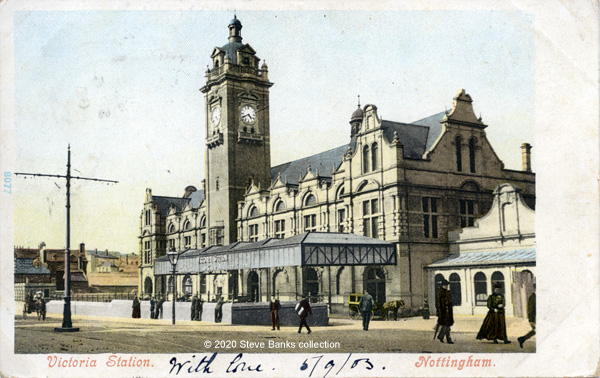
Thirdly, a Postcard only identified as "Great Britain and Ireland" and posted on 5th September 1903 , from Nottingham to Bedford. In this version the whole building has been colourised an elegant cream, alas falsely. On the awning can be seen the name, "Victoria Station".
Somewhat intriguingly, an earlier version of this card from the same source was black and white and captioned as "Great Central Station" even though underneath the station name can be seen "Great Central and Great Northern Railways".
It's to the earlier style in which only the address was written on the back and the front offered some white space where a message could be squeezed in. It had been posted by a man to his young son in Exmouth . C. Golder collection.
Click on the image for an enlargement
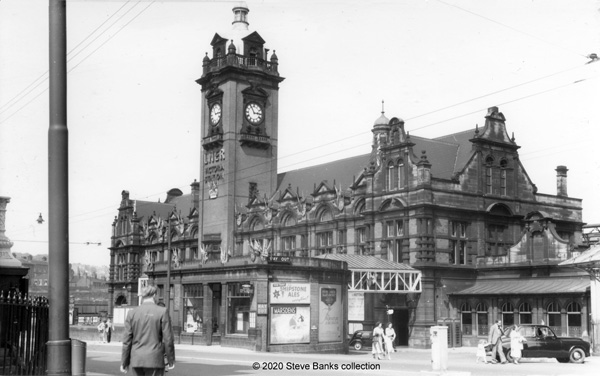
The fourth view is from 1953 and shows an enquiry office added in front of the awning and "LNER Victoria Station" high up on the clock tower. Queen Elizabeth's coronation took place that year and the number of flags and shields bedecking the frontage is astonishing. LGRP, author's collection.
Click on the image for an enlargement

Moving inside, this sepia postcard is from the late Victorian era soon after opening and was taken on Platform 4. A light engine is standing on the central road between the platforms. The glazed roof is pristine. To the right is a "Dining Room" and a busy bookstand. Platform 10 is on the far side. Kingsway Real Photo Series Post Card, unposted, author's collection.
Click on the image for an enlargement

Platform 10 as seen on 18th September 1964, still looking light and airy. M. Morris collection.
Click on the image for an enlargement

This view from the same day shows the panelled booking and ticket offices. W.H. Smiths has a prestigious location nearby. M. Morris collection.
Click on the image for an enlargement

This view from June 1910 is useful for showing the original frontage of the train shed with its exuberant glazing,
Parked on a central road is GCR Class 8E (LNER C5) No 364 Lady Henderson (renamed Lady Faringdon in 1917). At the time all four compound Atlantics were allocated to Gorton and used for expresses to Marylebone and back. No lights are being carried as yet and its likely next turn is not known. J.Scott-Morgan collection.
Click on the image for an enlargement
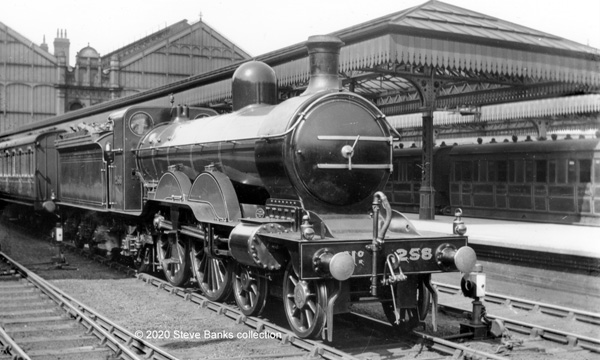
Captured a little later on 4th June 1912 is GNR Ivatt small Atlantic, No 258 (LNER C2). It would work back to the GNR at Grantham where it was allocated. J.Scott-Morgan collection.
Click on the image for an enlargement
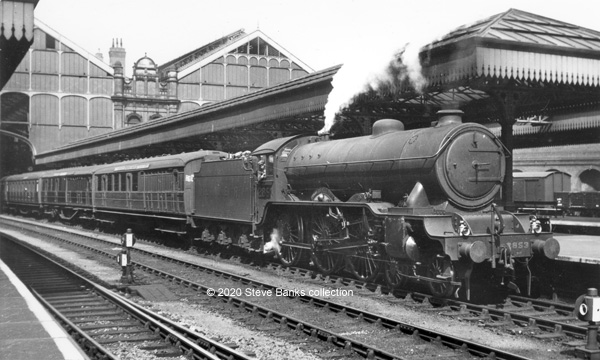
The LNER began modifications to the front of the train shed and in this late 1930s view partial removal of the glazing can be seen to improve the ventilation.
"Footballer" B17 No 2853 Huddersfield Town is pausing with the Newcastle-Swansea express. Note the through carriage (BCK) from Hull behind the tender carrying triple destination boards. Photo: Author's collection.
Click on the image for an enlargement
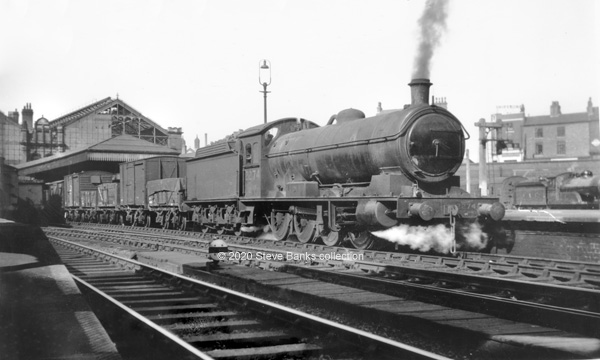
By 1945-46 more of the front glazing had been removed, a precursor of what was to follow.
The platform roads were used for all traffic passing through the station and a Class C goods train is waiting for a clear path. In charge is ex-NER Q6 0-8-0 No 2274, a long way from its home shed, Newport on the NEA.
Perhaps of greater interest is the 4-4-0 to the far right: it was the unique D3 which was rebuilt in 1944 for use with officers' saloons. A side-window cab was provided and a unique green livery with "N E" on the tender and the company crest in between, which is fairly clear on the print. It also received a Thompson number, 2000, which can just about be discerned. Photo: J.Scott-Morgan collection.
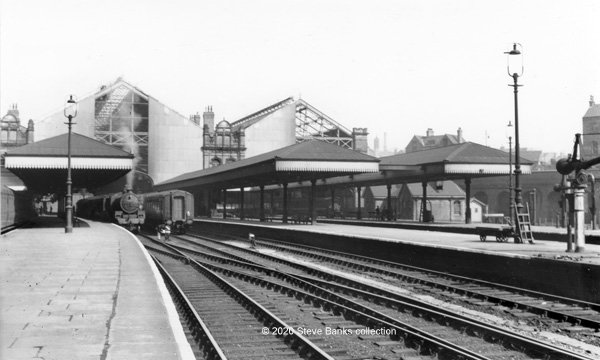
The south end of the platforms looking north in 1952, after large areas of the glazed frontage had been removed and only partly replaced with white corrugated asbestos. It may be viewed as post WW2 austerity but tasteless, especially when compared with the original handsome design. It wasn't helped by removal of the roof cladding on the far west and eastern sides. Smoke and grime gradually toned down the garish appearance and eventually gave it something of a "modern" look, but these things are in the eye of the beholder, really.
It's a quiet time of the day with some Gresley bow-ended carriages parked on one of the central roads and a B1 alongside with a modest Ordinary Passenger train. Photo: LGRP, author's collection.
Click on the image for an enlargement
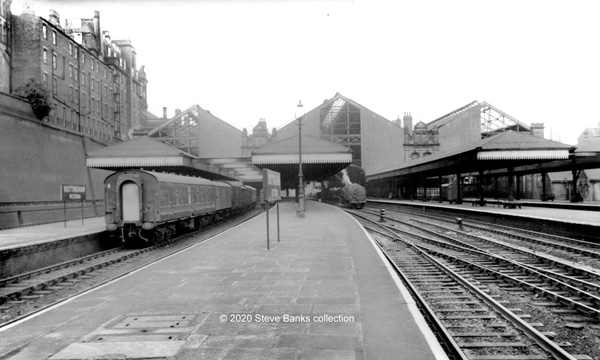
Another view from the same location but on Friday, 18th September 1964 showing how the roof on the far west side was also stripped. Rising high to the left is the rear of the station hotel. Half a dozen parcels vans stand in one of the south-facing bays. A B1 waits in the central road to the right while a goods train can be seen approaching. Photo: M. Morris collection.
Click on the image for an enlargement
2 - The north end

Pictures of the turntable at the north end of the station are rare because unlike at the other end, it was some distance from the platforms and not reached without a permit. In this view ex-GNR C1 4-4-2 No 1404 is close to the turntable, looking like it's just come of it after being turned to work a train back to Grantham where, in 1923 and 1924, it was allocated. Its later number of 4404 was applied in July '24 and the loco transferred soon after to King's Cross. Unusually, Express lights are already being carried. Photo: author's collection,
Click on the image for an enlargement
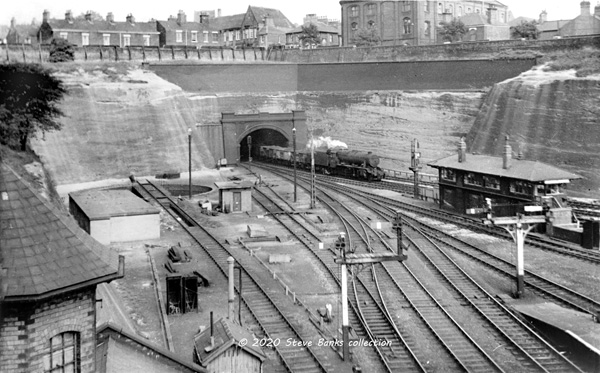
A general view of the north end showing the deep end and the scale of the excavations. The rock was self-supporting, but the higher levels needed a retaining wall. An 8F is emerging from the Mansfield Road tunnel with a coal train. To the left is the turntable (there was one at each end) and to the right, Victoria North signal box. It's September 1966 and all the lower quadrant signal arms had been replaced by Upper Quadrants, on the original GCR posts. Photo: G. Dawson.
Click on the image for an enlargement

The same scene from platform level on a sunny day. The signal box is seen more clearly and the strategically placed water columns, just right for tender locos. Photo: Author's collection.
Click on the image for an enlargement
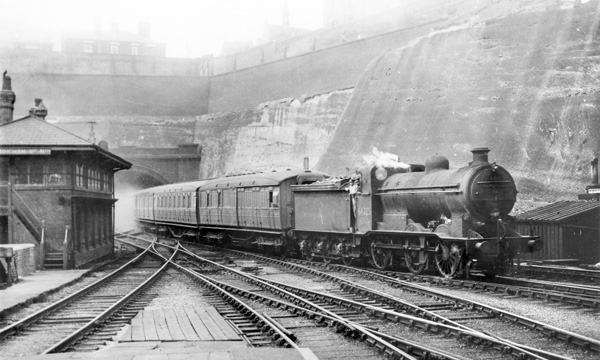
Back to ground level at the north end with a GN Ordinary Passenger headed by J6 No 64225 (Colwick - some records have it as a Woodford Halse engine). 1952. Photo: R.K. Blencowe Archive.
Click on the image for an enlargement
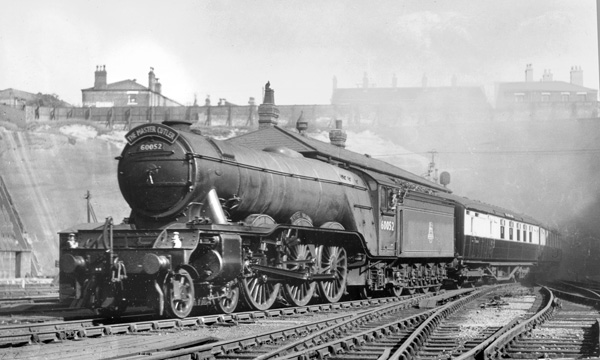
The early 1950s and A3 No 60052 Prince Palatine is passing Victoria North as it enters the station with the Up "Master Cutler". PhotoL T.G. Hepburn.
Click on the image for an enlargement
"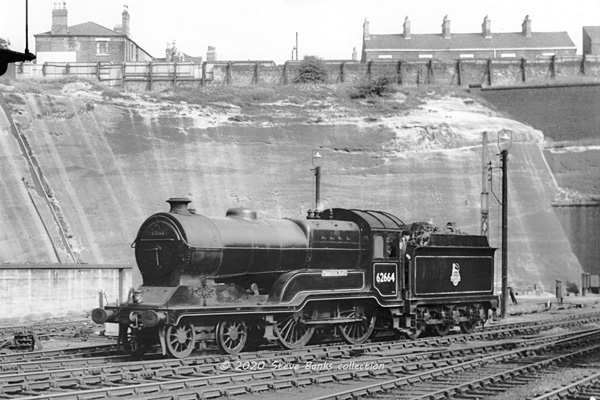
A view showing D11 No 62664 Princess Mary running light at the north end. The scale of the excavations at the north end really shows. Photo: D.B. Swale.
Click on the image for an enlargement

Moving away from the tunnel mouth to the platforms and already it's possible to see a reduced depth of excavations and a brick abutment sufficing.
It's the mid-1920s and ex-GCR D9 No 6017 (Sheffield) has an unidentified train with a GWR 6w passenger brake van at the head which would have come via Banbury. It could be the "Ports to Ports" or the Southampton-Glasgow. Photo: Author's collection.
Click on the image for an enlargement
3 - The shallower middle and south end.

Looking down on the south end and middle of the station from Lower Parliament Street, which you can see is not very high up. It is often presumed that the whole site was at a great depth like the extreme north end but it was cut into the side of a hill and shallower in the middle and this end, to the height of Lower Parliament Street and a modest retaining wall sufficed. This level continued along Glasshouse Street and the ground and the city can be seen rising further away from the site of the station.
Part of the exit from King's Cross was the same. It's also reminiscent of other GCLE stations which were built on falling ground, such as Helmdon and Brackley.
The turntable at this end was alongside the platforms and occasionally photographed with a loco on it. B1 No 61232 is waiting to take over from a failed "Black Five" on the 17.15 Marylebone. August 1965. Photo: G. Dawson.
Click on the image for an enlargement
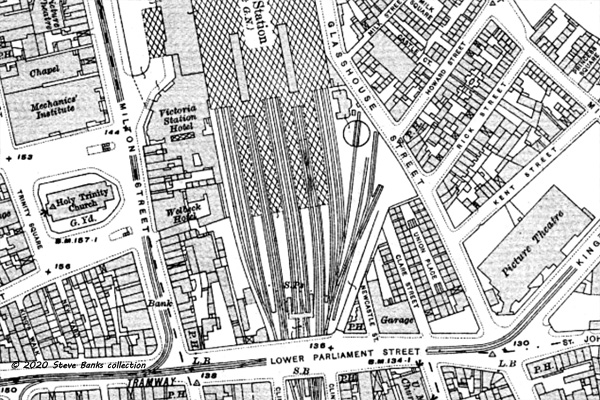
The south end of the station from the OS 25" map of 1911-13. In the lower right hand corner is a triangle of housing that was not demolished. Nearby stands a cinema where the local prison used to be while, out of sight to the north was the Nottingham Union Workhouse, reminders of the slum district which the GCR demolished and replaced with newly built houses. One of the new roads was even named "Watkin Street". Source: National Library of Scotland.
The garage belonged to R. Cripps & Co. Ltd. Note the twin stairs from Lower Parliament Street onto the platforms
Click on the image for an enlargement

An undated view from around 1910 showing GNR Single No 1006 at the south end of the station, turned, coaled and ready to take a train back to Grantham. No 1006 was one of the last ones built and apart from the preserved No 1, the class ceased to exist in 1916, having spent their last years in secondary services like this.
In the background is a Howlden 45' bogie van with plug doors. Photo: Author's collection.
Click on the image for an enlargement

A 1920s panorama showing how shallow much of the station was with short staircases onto the platforms. It was a convenient access from that part of town. In the middle distance is the road descending to the Up-side goods/parcels bay and platform, which had an end load for carriage trucks. An ex-GCR NPCS vehicle is parked there. Note the lower quadrant signals.
In the foreground stands one of Colwick's ex-GNR "Standard Goods", J3 No 4117. At their peak Colwick had 60 of them and they were at home on the GN passenger service to Grantham and Derby; note that lights are being carried for an Ordinary Passenger train. Photo: a much-repaired print from the HMRS.
Click on the image for an enlargement

One of Grantham's s ex-GNR D2s, No 3045, in 1934 at the south end of the platforms with a good view of the steps descending from Lower Parliament St. which was at normal bridge height. The excavation of most of the site was at this depth for the streets that crossed it - this one and Charlotte Street (later named Central Road and then Union Rd) - and did not need to be any deeper. From this angle the landing halfway down is seen clearly. My apologies for retaining some of the tilt but correcting it would have meant cropping more of the steps.
The south signal box can be seen beyond the bridge carrying Lower Parliament St., originally named Victoria South, later Nottingham Victoria South. Photo: J. Scott-Morgan Collection.
Click on the image for an enlargement

A relatively rare picture of an Up train departing, which has captured part of the steps onto the platform. Ex-GCR "Improved Director" D11 No 5502 Zeebrugge is setting off with the 2.20pm Manchester-Marylebone on 21st May 1933. Photo: Author's collection.
Click on the image for an enlargement
4 - Up non-passenger facilities

Looking across the tracks in 1956-57 towards the east side and the earthworks so low that they can hardly be seen. To the right the access road descends to the Up goods and parcels platform, the term "parcels" denoting traffic sent by or attached to passenger trains, especially the perishable kind, as well as horses and heavy items loaded on a carriage truck, for which an end load was provided, for all of which a road vehicle could get close without any trouble. Cattle would have been handled in goods yards equipped with pens. Light parcels were handled on the passenger platforms using the van space in passenger train brake-ends, and long distance passenger brake vans. Routine parcels traffic was well organised and my aim here is merely to show the different methods and facilities provided in such a large station.
A Colwick ex-GNR J6, No 64256, has a Derby-Grantham train with a modern Thompson carriage at the head. Photo: R.S. Carpenter.

Another tantalising partial view, this one from the late 1930s, showing the access road onto the loading area and various items scattered around. A loading gauge was placed by the plaftorm to guard against over-loading of open wagons.
In the foreground stands one of Leicester's C4s, No 5260, about to depart southwards. The train is based on a non-gangwayed 4-set of ex-GCR 50' carriages of c1904 - clerestory and London Suburban - to which a contrasting modern carriage has been added as a strengthener: a 61'6" Gresley BTK for the run to Leicester. Photo: HMRS.
Click on the image for an enlargement
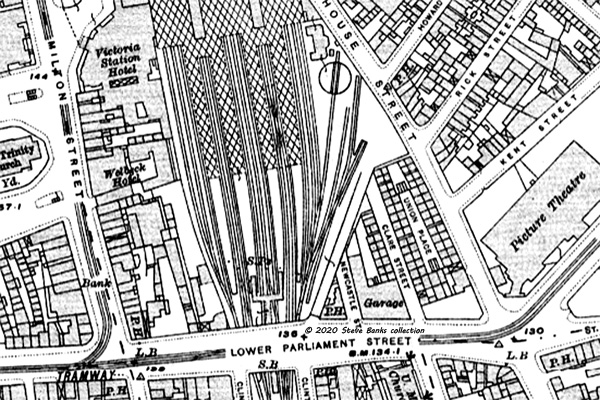
An enlargement of the 25" OS map (1911-13) for the Up goods and parcels platform, how it was reached, and how it stretched from the abutment by Glasshouse St. to a ramp beyond the bay with the end load. The loco turntable was nearby. Source: National Library of Scotland.
Click on the image for an enlargement

A general view from track level looking towards the Up goods and parcels platform with Glasshouse St. behind.
The height of the abutment is deceptive because it was only up to the architectural feature just above the arches, a mere 15 feet or so. Above that was a high wall by the side of the street to prevent horses - which were the main motive power on the roads - from being distracted by the sight and sound of steam engines whose safety valves blowing off could frighten a horse and make it shy. A panicking horse was a danger to all around as well as itself and its rider. Cases are known of a panicking horse jumping a wall and falling onto the railway with fatal consequences. It was a well recognised problem when horses were everywhere and railway companies took sensible precautions. In other words we're not looking at a deeply excavated area but a shallow one with a high safety wall.
The end load for flat wagons and carriage trucks stands out with its lack of buffers. The date of the BR-period picture is not known but it looks like the goods platform was out of use, the original loading gauge removed, and the area serving as a car park. I recognise a Farina-design 1100 (my dad had one) and a Morris Minor.... Photo: Author's collection.
Click on the image for an enlargement
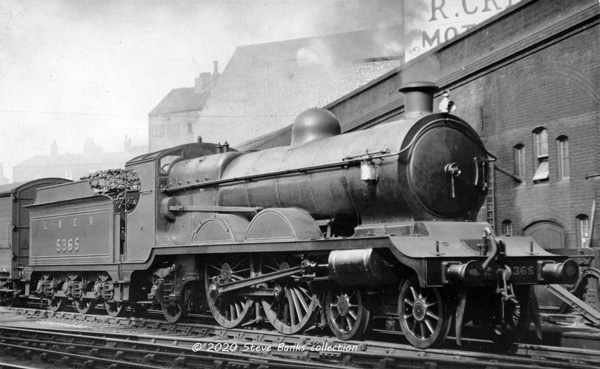
This view from the late 1920s shows how ex-GCR C5 No 5365 Sir William Pollitt has come off an Up Ordinary Passenger train to collect a CCT from the bay and is now heading back to its carriages. The train loco was routinely used when NPCS had to be added or set down. Photo: W. Leslie Good, author's collection.
Click on the image for an enlargement

The final view in this sequence shows ex-GCR D9 No 6035 being turned on the Up turntable. It was at Colwick 1928-36 and would have been rostered for Ordinary Passenger services up and down the Extension, which lights it is carrying. Note the AVB-fitted van at the NPCS platform.
By the way, the curvature of the high wall by Glasshouse Street is not real - it's an optical effect called barrel distortion from a very poor lens (the sharpness isn't anything to write home about either)! Photo: LGRP.
Click on the image for an enlargement
5 - Down non-passenger facilities
The facilities on the down side were a marvel of squeezing a quart into a pint pot with an Alpine-style descent from Milton Road close to the main station frontage which can just be glimpsed on the old colourised potscards. Alas, I have only two detail pictures and they only show part of the scene so it's best to begin with the OS 25" map:
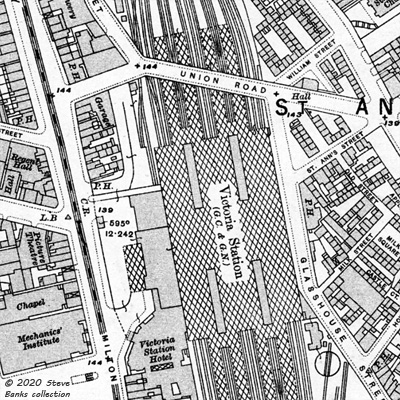
Taken from the 1913-15 edition, the access can be seen by the public house (P.H.) on the Milton Road and how the platform was arranged. Source: National Library of Scotland.
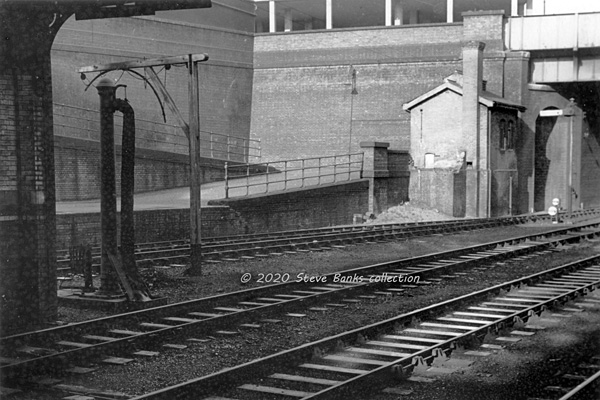
The better view is from BR days and shows the bottom of the descent and part of the NPCS platform with the Union Road bridge (where Charlotte Street used to be and initially named Central Road) rising above it. Railings were provided to aid visibility on the reverse bend on the descent and the platforms were also arrangement in a different way.
Two sidings can be seen, protected by ground signals and an upper quadrant on a tubular post. The nearer siding is for the main platform, the further one for the end load. The original loading gauge is still in place despite having been retired. Photo: author's collection.
Click on the image for an enlargement

This view from the other direction is useful although I apologise for the dire quality and shall refrain from identifying its source. The view is not dated but it looks like around the time of closure. In the distance, it's possible to see more of the descent from Milton Road, the non-passenger platform and end load, and how the platform ran underneath the station building. Photo: author's collection.
6 - Secondary services - GC Section
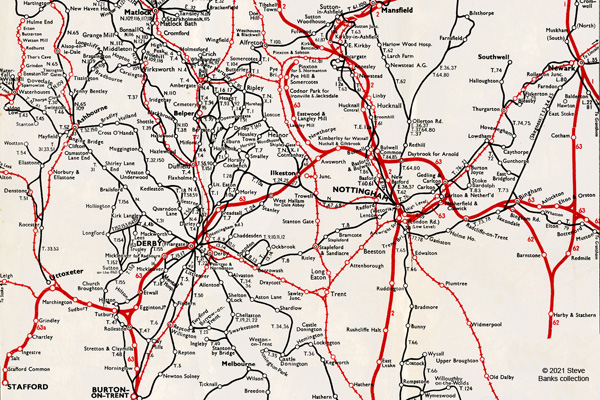
This is part of the map supplied by the LNER with its Passenger Timetables booklet for 1939, the thick red lines being LNER, the thin red ones, LMS. Lines originally part of the GCR run north-south and the GNR, west-east. Off the map to the west lay Stoke and to the east, Grantham.
In LNER days the service was combined with the engine shed at Colwick taking over so it's hard to separate the workings entirely, which are often ambiguously and incorrectly described as "suburban services" but as the maps shows, they covered a wide area. It's just a pity that photographers were so smitten by the good ol' choo-choo that most of the pictures taken here were of the locos and rarely of the trains they worked. Some of the pictures are in the station sections and I have not repeated, focus here is on the workings and the locos employed.
The GCR built a 4-road engine shed just south of Arkwright St. station and known as such but, locally, as Queen's Walk (a photograph miscaptioned as "Queen's Road" threw me on a long wild goose chase - grr)! It closed in 1909 only remaining as a servicing point thereafter. Loco allocations were then to Annesley until LNER days when the ex-GNR shed at Colwick took over as the shed for the district.
Click on the image for an enlargement
(i) Along the GCLE
The station, with its near NE-SW alignment was a popular location with photographers for views of trains and portraits of locomotives, especially at the southern end and here is an example. However, this is more than a choo-choo picture and much can be said about the GCLE and its workings!

This picture of ex-GCR D9 No 6022 was taken on Tuesday 7th June 1927 and being a sunny day with clear shadows, a lot can be worked out using WTTs and CWBs. Note that a single light is being carried per a light engine movement. Train lights will be added when the loco couples up to its train.
In the background is one of Colwick's J2s, No 3078. Photo: Author's collection.
Click on the image for an enlargement
The loco was based at Annesley and my estimate of the time of day is approx 3pm for which there were two possibilities for trains that the loco was about to take charge of:
2.50pm Nottingham Vic - Rugby 3.40pm Nottingham Vic - Leicester
- The second one can be ruled out because this was the daily express from Cleethorpes-Leicester and was normally worked through by an Immingham 4-6-0.
- The earlier train was an Ordinary Passenger which was part of a complex roster for a Leicester non-gangwayed 4-set (BT, F, T, BT), probably made up with ex-GCR clerestories, which shuttled up and down the GCLE and was well suited to a light passenger 4-4-0.
The set's immediately prior working was to Ollerton (on the former LD&EC to the NE of Nottingham) and back, which may have been worked by a passenger tank engine. On arrival at Nottingham Victoria at 2.7pm, almost 3/4hr was allowed for the loco to come off and a tender loco to take over for the rest of the roster. Note how full the tender was, an indication that there would be no more refuelling during the day.
The roster varied between Saturdays and Saturdays Excepted - the latter being the case here - and the next journey was all-stations to Rugby Central where the train terminated from 4.26pm to 5.45pm. The loco would have drawn the carriages into one of the sidings and eventually run round them ready for departure all-stations to Loughborough, which would have been worked tender-first.
At Leicester, five minutes were allowed before continuing to Loughborough where the train changed direction again and the D9 had to run round once more. This this time, however, in returning to Leicester, it ran chimney-first.
In this third visit of the day to Leicester, the pause was an extended one lasting 49 minutes and it allowed the D9 to be turned to face north for its final leg: Leicester-Nottingham and Mansfield.The day ended with another tender-first leg, ECS to New Basford carriage sidings.
A key element of this roster was the service to Rugby and Loughborough at both of which the train changed direction and the loco had to run round and, because neither station had a turntable, a certain amount of tender-first running was required. This kind of thing is rarely "seen" by modellers, because it was rarely photographed! Such services with intermittent use of a set during the day were often provided for passengers to and from wayside stations connecting with through expresses.

I have found a second picture of D9 No 6022, taken in 1928 approaching Loughborough from the north with a non-gangwayed Ordinary Passenger 4-set. It's impossible to say for certain if this was the roster described above but it's quite likely. The formation is the same (BT, F, T, BT) and the carriages were:
ex-GCR |
BT |
3rd brake |
50' London Suburban |
ex-GCR |
F |
1st |
50' London Suburban |
ex-GCR |
T |
3rd |
60' Robinson |
ex-GCR |
BT |
3rd brake |
50' London Suburban |
The 50' London Suburban carriages had been cascaded from Marylebone after arrival off Robinson's matchboard versions, of which the 60' 3rd was an example; it was a 10-compartment carriage. Photo: W.L. Good.
Click on the image for an enlargement
New info:
I have also worked up a similar loco at the same place around the same time with part of the train visible, actually a bogie fish at the head. See "GCR bogie fish vans" (link below) under "In Service":
This train would have been a good candidate for routing NPCS from Nottingham to Leicester, another picture of an Ordinary Passnger service between the two cities conveying a cattle wagon.
(ii) To Mansfield and the LD&EC

A5 4-6-2T No 68905 first came to Colwick in 1950 for a period of 6 months, and again between May 1957-September 1959. It's about to depart from one of the north bays, possibly towards Mansfield, and the leading carriage is a Gresley 51' 1 1/2" brake end. Photo: R.S. Carpenter collection.
Click on the image for an enlargement

Seen at Mansfield, which closed to normal service passenger trains in January 1956, is A5 No 69821 with a train for Nottingham Victoria. It was twice at Langwith Jc (40E) as seen here, briefly in 1952 and 1955, then being transferred to Colwick. Only the leading carriage can be seen and it's an ex-GCR 50' London Suburban 3rd brake of c1905, which means that it was almost 50 yrs old and a good example of how elderly carriages were retained on minor lines where there was little or no competition. Photo: author's collection.
Click on the image for an enlargement

Another view at Mansfield but of a train that has terminated there and the unidentified Colwick J6 has run round and is about to work back to Nottingham. The leading carriage is a late 1930s-built Gresley BT(6) and the formation appears to be:
BT |
51'1 1/2" Gresley |
CL |
52'4" Thompson |
BT |
52'4" Thompson |
Photo: author's collection.
Click on the image for an enlargement
7 - Secondary services - GN Section
GNR and LNER era
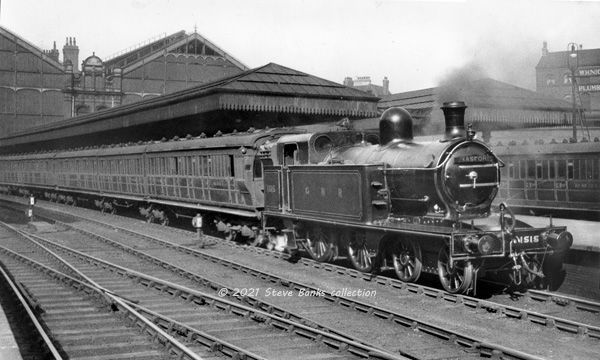
This pre-Grouping view shows GNR Class C2 (LNER C12) of 1899, No 1515, which had been built for King's Cross with low chimney and dome. The photographer's note on the back states "The 4-4-2Ts had just arrived from KX", which would have been between 1918-23 and, once at Colwick, this one remained there most of the rest of its life. Nearly half of the class was to work out of Colwick.
A headboard for BASFORD is being carried although that was to the north of the station. Six carriages can be seen but, alas, no more. Leading is an articulated triplet set followed by two Howlden 8w carriages. More GNR carriages can be seen in the bay. Photo: T.G. Hepburn.
Click on the image for an enlargement
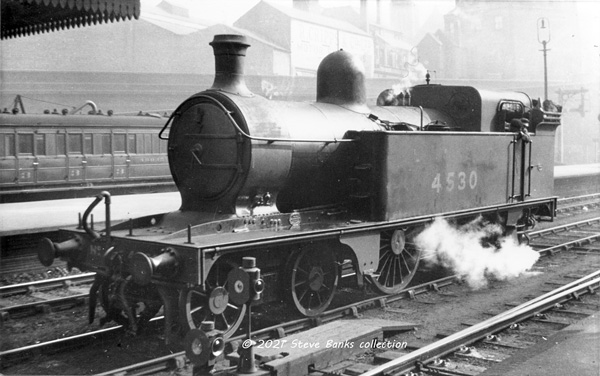
Seen in March 1931, C12 4-4-2T No 4530 stands in the middle road with no lights, possibly while serving as station pilot. This loco had come to Colwick just before the Grouping and stayed until 1933 (when it was moved to the West Riding). Photo: Real Photographs.
Click on the image for an enlargement
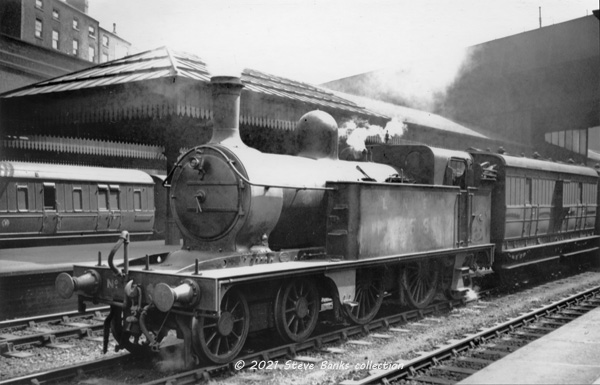
By May 1935, pre-Grouping arrival No 1515 had received a tall chimney and dome and been renumbered 4515. It's carrying Ordinary Passenger lights with an ex-GNR 6w carriage brake leading and more ex-GNR stock behind it, probably about to work one of the Nottingham-based local services. This C12 was to be one of the first withdrawals in 1937. Photo: Transport Treasury.
Click on the image for an enlargement
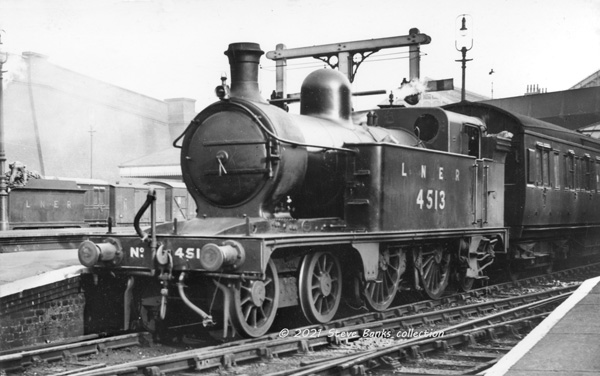
It's May 1938 and C12 No 4513 is at Platform 3 with quite likely a GC working to Mansfield and an ex-GCR matchboard carriage leading, cascaded from Marylebone when the LNER supplied new carriages for its Outer Suburban service and replacing, at Nottingham, the previous generation of cascaded carriages, ex-GCR 50' clerestory and London Suburban designs. Photo: J.P. Wilson.
Click on the image for an enlargement

So many old photos carry guesswork captions and this one of Colwick's J5 No 3027 is an example. The date is quoted as "1925" but that can be ruled out by the loco livery and the modern, recently built teak carriage on steel angle trussing (actually built in 1938 as a BT(6) to D.246). The train is probably destined for Grantham. Photo: Guillford collection.
Click on the image for an enlargement
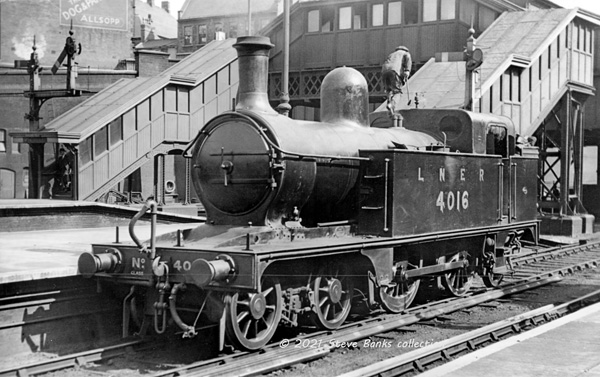
This beautiful picture also dates from 1938-39 and shows tall chimney and dome C12 No 4016 which was at Colwick from 29-11-38. Behind it the footbridge shows well, and how its height was greater than required to cross the tracks, because it connected with a public entrance on Parliament Street. Photo: R.K. Blencowe collection.
Click on the image for an enlargement
The Ivatt D2s
Secondary tender locos were used for the longers distance workings to Derby, Leicester and Grantham, especially the ex-GNR D2s, nearly all housed at Colwick (with a smaller number at Grantham). The class was ideal for lightly loaded minor services and it tends to be forgotten that between the two wars, Colwick's allocation was by far the highest on the LNER with a total of 13 on its books. I suspect that being so common around Nottingham they were so taken for granted that relatively few were photographed and they are barely mentioned in RCTS 3B either. I have one LNER-period picture (which I've transferred here temporarily) yet three after WW2 when the class was scrapped out of existence. It's as if photographers had realised their demise was imminent and came to Nottingham for a last chance to record them. The very last one was at Colwick and scrapped in 1951.

This undated picture of ex-GNR D2 No 3045 was probably taken in 1934 when it spent almost half a year at Grantham from where it would have worked in and was photographed before being turned to work back. The photograph also shows the footbridge and south signal box and is captioned accordingly in that section. Photo: J. Scott-Morgan Collection.
Click on the image for an enlargement
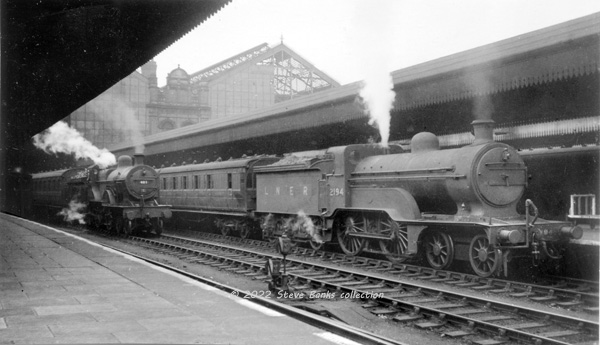
Ex-GNR Ivatt 4-4-0 D2 No 2194 (COL) is seen c1948 with its Thompson number (of 1946, the loco was withdrawn in 1949). The loco may have been some forty years old but the leading carriage, a Howlden 45' 3rd brake, was older still. It dated back to 1891 which means it would have been about 57 years old.
Standing in the centre road is an LMS 4-4-0, a 2P No 402 with smokebox running number and shed plate, alas unreadable. Photo: Author's collection.
Click on the image for an enlargement

Ex-GNR Ivatt 4-4-0 D2 No E2188 (COL) received this BR version of its number in February 1948 and was condemned the following year in October 1949. It may have been a murky day but the loco, at least beyond the tender, looks quite clean and we may be seeing the post-works condition after its last general overhaul being maintained by the cleaners.
It was captured on Saturday 23rd July 1949 in one of the north bays with an Ordinary Passenger train, probably Nottingham-Derby. An element of upgrading can be seen via an ex-GER Holden 50' gangwayed 3rd brake - BTK(3) to GE.541E. Photo: Author's collection.
Click on the image for an enlargement

The final picture shows a more typically tired D2 No 2193 (COL) whose number had been applied in December 1946 and the loco condemned in June 1949. It had come to Colwick in December 1947 so the photo can be dated between 12/47 - 6/49, which is relevant for the newly fitted white asbestos screens on the ends of the train shed.
It is standing in the centre road at the south end and the leading carriage is a relatively modern late-1930s Gresley BT(6) on steel angle trussing. In the background stands an N2 that has been relettered "BRITISH RAILWAYS". Five were allocated to Colwick for a few years around this time for local services, but apparently were unpopular and one suffered a derailment. Shades of their deployment in the West Riding. They were better suited to the extremely well-maintained GNML out of King's Cross. Photo: F.A.Blencowe.
Click on the image for an enlargement
BR days
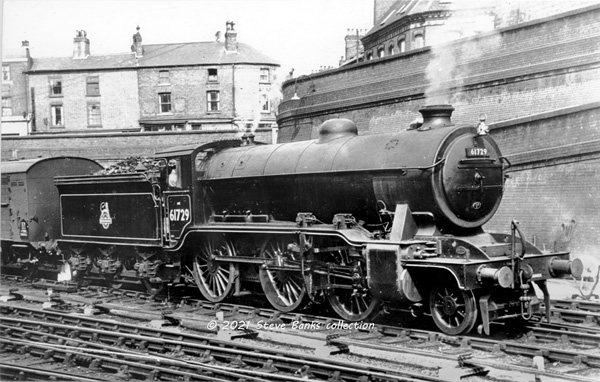
The quality of this anonymous copy may be iffy but it's another useful view of the Up "horse and carriage dock" being used. In 1952, K2 No 61729 with Ordinary Passenger lights is marshalling an ex-GWR horse box. This was a Colwick loco and it may have been working a train to Grantham rather than southwards on the GCLE. Photo: Author's collection.
Click on the image for an enlargement
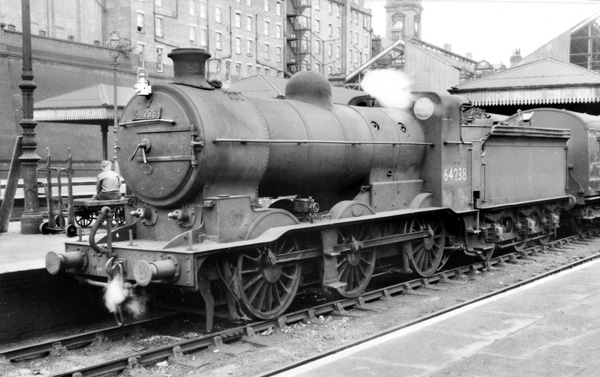
A J6, No 64238, which was at Colwick between 1951-59, waits to leave one of the south bays with a train for Grantham. Only a fraction of the leading LNER steel-panelled carriage can be seen and it looks like a Thompson. Photo: author's collection.
Click on the image for an enlargement
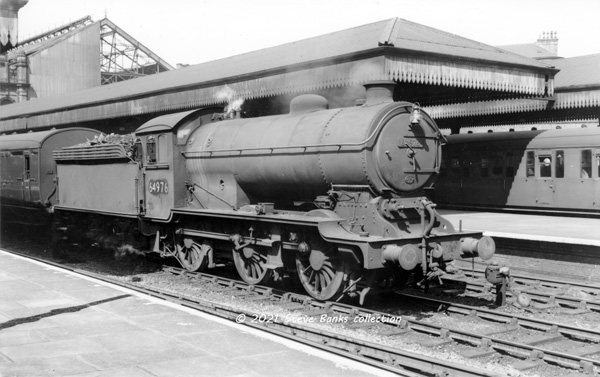
Standing in the middle road with Thompson 52'4" stock is J39 No 64976 and it's not clear if this will be for a train to Grantham or Leicester. The loco was at Colwick between 1953-59 and it's the first view in this sequence in which no pre-Grouping stock can be seen. Photo: author's collection.
Click on the image for an enlargement
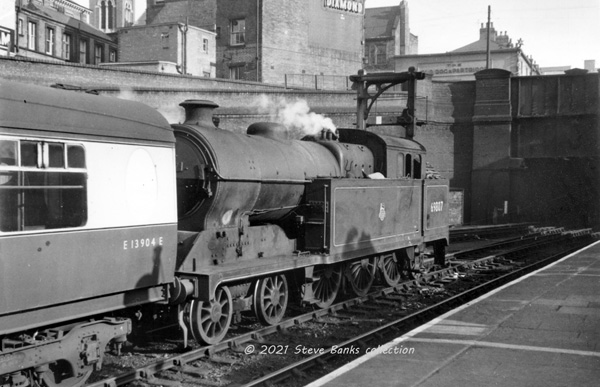
A more modern scene from 23rd August 1958 with A5 No 69807 about to depart with the 5.0pm Nottingham Victoria-Grantham. This loco came from Neasden in January 1950 and was at Colwick until withdrawal shortly after this picture was taken. Note the introduction of Thompson gangwayed stock, although it may only have been the odd coach. Photo: author's collection.
Click on the image for an enlargement

An undated view of a similar service now in the hands of Thompson L1 No 67771. The train is made up with Thompson 52'4" non-gangwayed stock. An unidentified ex-GCR A5 can be seen alongside. Photo; author's collection.
Click on the image for an enlargement
8 -1960s specials
In late 1966 there were identically named "Great Central Rail Tour" specials organised by the RCTS on 13th August 1966 and by the LCGB on 3rd September 1966. Much of the story can be found on the excellent w/s Six Bells Junction and I don't propose to go into details but I can offer a couple of pictures:
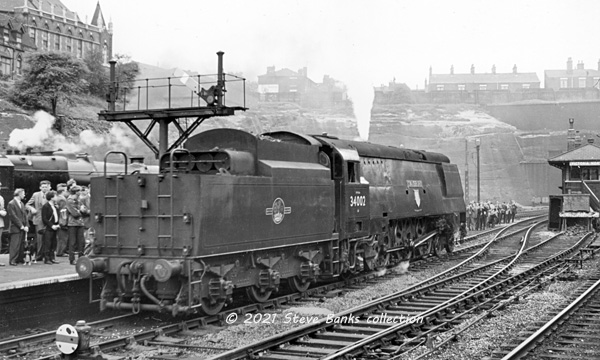
The first special by the RCTS ran from Waterloo to Penistone on the 1500DC lines and was brought into Nottingham Vic by ex-SR "West Country" Pacific No 34002 Salisbury. I think that this picture was taken as the loco was giving way to an 8F, then a B1 and on the final part, a Wath E260xx. Crikey, that was some tour! The return route was slightly different and Salisbury took the train back from Nottingham Vic to Marylebone, which was quite fitting really. Photo: author's collection possibly Mervyn Leah.
Click on the image for an enlargement

The second special was organised three weeks later by the LCGB with a broadly similar route but a "Merchant Navy" to Nottingham and two B1s (61131+61173) - that's more like it! - to the north. The picture appears to show 61173 taking water before being coupled to its partner.
My apologies for the quality of the picture but the slide is quite dark and has taken quite a visit by Ye Olde Photoshoppe. Photo: author's collection.
Click on the image for an enlargement
To be continued...
Other locations on the GCLE:


